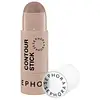What's inside
What's inside
 Key Ingredients
Key Ingredients

 Benefits
Benefits

 Concerns
Concerns

 Ingredients Side-by-side
Ingredients Side-by-side

Isononyl Isononanoate
EmollientOctyldodecanol
EmollientOzokerite
Emulsion StabilisingTriethylhexanoin
MaskingDimethicone
EmollientCI 77891
Cosmetic ColorantKaolin
AbrasiveCI 77492
Cosmetic ColorantSynthetic Wax
AbrasiveAluminum Starch Octenylsuccinate
AbsorbentMicrocrystalline Wax
Emulsion StabilisingCI 77499
Cosmetic ColorantCI 77491
Cosmetic ColorantMethyl Methacrylate Crosspolymer
Silica
AbrasiveEuphorbia Cerifera Wax
Simmondsia Chinensis Seed Oil
EmollientTocopheryl Acetate
AntioxidantGlyceryl Caprylate
EmollientAlumina
AbrasiveParfum
MaskingIsononyl Isononanoate, Octyldodecanol, Ozokerite, Triethylhexanoin, Dimethicone, CI 77891, Kaolin, CI 77492, Synthetic Wax, Aluminum Starch Octenylsuccinate, Microcrystalline Wax, CI 77499, CI 77491, Methyl Methacrylate Crosspolymer, Silica, Euphorbia Cerifera Wax, Simmondsia Chinensis Seed Oil, Tocopheryl Acetate, Glyceryl Caprylate, Alumina, Parfum
Caprylic/Capric Triglyceride
MaskingIsostearyl Isostearate
EmollientOctyldodecanol
EmollientAluminum Starch Octenylsuccinate
AbsorbentLauroyl Lysine
Skin ConditioningCI 77891
Cosmetic ColorantDimethicone
EmollientDicalcium Phosphate
AbrasiveEuphorbia Cerifera Wax
Copernicia Cerifera Wax
Dimethicone/Vinyl Dimethicone Crosspolymer
Skin ConditioningCI 77499
Cosmetic ColorantOryza Sativa Bran Wax
Skin ConditioningSynthetic Beeswax
Emulsion StabilisingCI 77492
Cosmetic ColorantDisteardimonium Hectorite
StabilisingCI 77491
Cosmetic ColorantHelianthus Annuus Seed Wax
Skin ConditioningSynthetic Wax
AbrasiveTocopherol
AntioxidantPropylene Carbonate
SolventHelianthus Annuus Seed Oil
EmollientChlorella Vulgaris Extract
Skin ConditioningRosmarinus Officinalis Leaf Extract
AntimicrobialCaprylic/Capric Triglyceride, Isostearyl Isostearate, Octyldodecanol, Aluminum Starch Octenylsuccinate, Lauroyl Lysine, CI 77891, Dimethicone, Dicalcium Phosphate, Euphorbia Cerifera Wax, Copernicia Cerifera Wax, Dimethicone/Vinyl Dimethicone Crosspolymer, CI 77499, Oryza Sativa Bran Wax, Synthetic Beeswax, CI 77492, Disteardimonium Hectorite, CI 77491, Helianthus Annuus Seed Wax, Synthetic Wax, Tocopherol, Propylene Carbonate, Helianthus Annuus Seed Oil, Chlorella Vulgaris Extract, Rosmarinus Officinalis Leaf Extract
 Reviews
Reviews

Ingredients Explained
These ingredients are found in both products.
Ingredients higher up in an ingredient list are typically present in a larger amount.
Aluminum Starch Octenylsuccinate is a synthetic powder used as an absorbent, thickener, and anti-caking agent.
As an absorbent, it is great at mattifying skin by soaking up the oil. This is why you'll find it in a range of products from makeup to moisturizers.
This ingredient is considered a modified starch. Starch can also be found naturally in plants.
One study from 1991 found that 5% of this ingredient enhanced titanium dioxide SPF by as much as 40%. The study found 1% titanium dioxide had a 5.6 SPF and adding 5% of aluminum starch octenylsuccinate boosted it to an SPF of 8.1
Although “aluminum” in an ingredient name can raise red flags for some consumers, the form and usage context matter significantly. For typical topical applications, there is no substantial evidence of health risks - such as cancer, neurotoxicity, or systemic “aluminum overload.”
Learn more about Aluminum Starch OctenylsuccinateCi 77491 is also hydrated iron III oxide. It's sole purpose is to give a red/pink hue to products.
Iron III oxides are classified as inorganic chemicals for coloring.
Synthetically created Ci 77491 is considered safer than those naturally found. This is because the synthetically created version may contain less impurities. Iron oxides are generally non-toxic and non-allergenic.
Learn more about CI 77491Ci 77492 is also hydrated iron III oxide. It's sole purpose is to give a yellow hue to products.
Iron III oxides are classified as inorganic chemicals for coloring.
Synthetically created Ci 77492 is considered safer than those naturally found. This is because the synthetically created version may contain less impurities. Iron oxides are generally non-toxic and non-allergenic.
Learn more about CI 77492Ci 77499 is also hydrated iron III oxide. It is created from mixing red and black iron oxides. This helps give shades of darkness to a product.
Iron III oxides are classified as inorganic chemicals for coloring.
Ci 77891 is a white pigment from Titanium dioxide. It is naturally found in minerals such as rutile and ilmenite.
It's main function is to add a white color to cosmetics. It can also be mixed with other colors to create different shades.
Ci 77891 is commonly found in sunscreens due to its ability to block UV rays.
Learn more about CI 77891Dimethicone is a type of synthetic silicone created from natural materials such as quartz.
What it does:
Dimethicone comes in different viscosities:
Depending on the viscosity, dimethicone has different properties.
Ingredients lists don't always show which type is used, so we recommend reaching out to the brand if you have questions about the viscosity.
This ingredient is unlikely to cause irritation because it does not get absorbed into skin. However, people with silicone allergies should be careful about using this ingredient.
Note: Dimethicone may contribute to pilling. This is because it is not oil or water soluble, so pilling may occur when layered with products. When mixed with heavy oils in a formula, the outcome is also quite greasy.
Learn more about DimethiconeOctyldodecanol is a fatty alcohol. It is primarily used to enhance the texture of products.
As an emulsifier, Octyldodecanol helps prevent the oils and waters from separating. It also prevents ingredients from creating foam when shaken.
Octyldodecanol is created by reducing fatty acid to an alcohol.
Due to its high molecular weight, it does not get absorbed into the skin.
Learn more about OctyldodecanolSynthetic Wax is created from fossil fuels such as natural gas. It is used to enhance texture, adjust pH, and as an occlusive.
It may also be used as an abrasive ingredient to exfoliate the skin.
Synthetic Wax may not be fungal acne safe.
Learn more about Synthetic WaxEuphorbia Cerifera wax comes from a shrub in Northern Mexico. It is used to stabilize formulations and has emollient properties.
Emollients form a thin layer on top of skin to prevent water from evaporating, keeping skin and lips hydrated.
According to a manufacturer, this wax can range from a yellow/brown color to translucent.
Learn more about Euphorbia Cerifera Wax